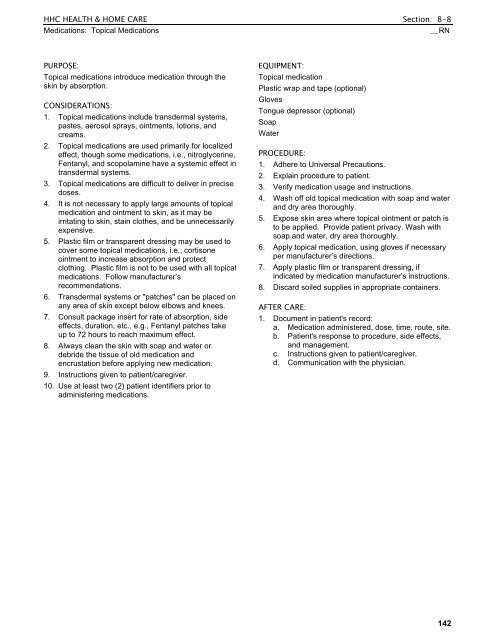HHC Health & Home Care Clinical Policy And
HHC Health & Home Care Clinical Policy And
HHC Health & Home Care Clinical Policy And
Create successful ePaper yourself
Turn your PDF publications into a flip-book with our unique Google optimized e-Paper software.
<strong>HHC</strong> HEALTH & HOME CARE Section: 8-8<br />
Medications: Topical Medications __RN<br />
PURPOSE:<br />
Topical medications introduce medication through the<br />
skin by absorption.<br />
CONSIDERATIONS:<br />
1. Topical medications include transdermal systems,<br />
pastes, aerosol sprays, ointments, lotions, and<br />
creams.<br />
2. Topical medications are used primarily for localized<br />
effect, though some medications, i.e., nitroglycerine,<br />
Fentanyl, and scopolamine have a systemic effect in<br />
transdermal systems.<br />
3. Topical medications are difficult to deliver in precise<br />
doses.<br />
4. It is not necessary to apply large amounts of topical<br />
medication and ointment to skin, as it may be<br />
irritating to skin, stain clothes, and be unnecessarily<br />
expensive.<br />
5. Plastic film or transparent dressing may be used to<br />
cover some topical medications, i.e., cortisone<br />
ointment to increase absorption and protect<br />
clothing. Plastic film is not to be used with all topical<br />
medications. Follow manufacturer’s<br />
recommendations.<br />
6. Transdermal systems or "patches" can be placed on<br />
any area of skin except below elbows and knees.<br />
7. Consult package insert for rate of absorption, side<br />
effects, duration, etc., e.g., Fentanyl patches take<br />
up to 72 hours to reach maximum effect.<br />
8. Always clean the skin with soap and water or<br />
debride the tissue of old medication and<br />
encrustation before applying new medication.<br />
9. Instructions given to patient/caregiver.<br />
10. Use at least two (2) patient identifiers prior to<br />
administering medications.<br />
EQUIPMENT:<br />
Topical medication<br />
Plastic wrap and tape (optional)<br />
Gloves<br />
Tongue depressor (optional)<br />
Soap<br />
Water<br />
PROCEDURE:<br />
1. Adhere to Universal Precautions.<br />
2. Explain procedure to patient.<br />
3. Verify medication usage and instructions.<br />
4. Wash off old topical medication with soap and water<br />
and dry area thoroughly.<br />
5. Expose skin area where topical ointment or patch is<br />
to be applied. Provide patient privacy. Wash with<br />
soap and water, dry area thoroughly.<br />
6. Apply topical medication, using gloves if necessary<br />
per manufacturer’s directions.<br />
7. Apply plastic film or transparent dressing, if<br />
indicated by medication manufacturer’s instructions.<br />
8. Discard soiled supplies in appropriate containers.<br />
AFTER CARE:<br />
1. Document in patient's record:<br />
a. Medication administered, dose, time, route, site.<br />
b. Patient's response to procedure, side effects,<br />
and management.<br />
c. Instructions given to patient/caregiver.<br />
d. Communication with the physician.<br />
142







